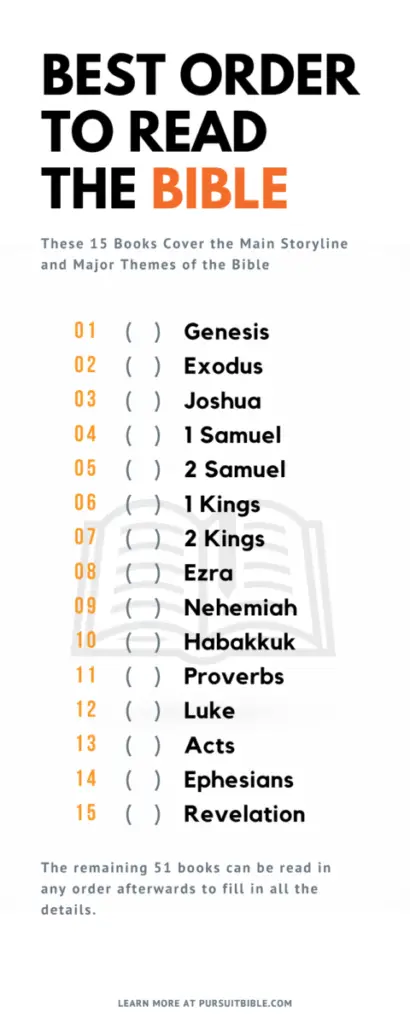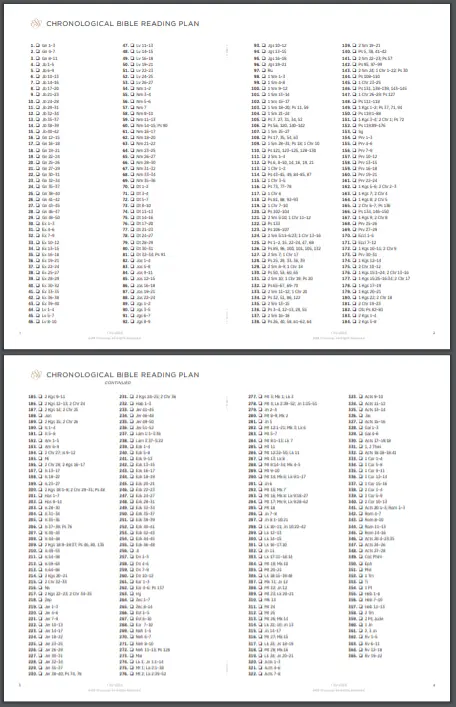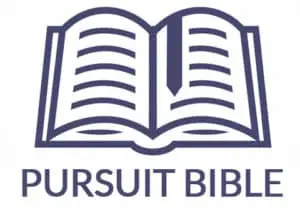Do you read the Bible like most books, in order from beginning to end? Or are there other recommended ways to read it? This is a common question because the Bible is a long book. It can seem confusing and even intimidating at first to know where to start.
Everyone who wants to start reading the Bible has been there. I want to share with you what I’ve learned from my experience of reading through the Bible and helping others do the same.
Should you read the Bible in order? Most people should not read the Bible in order. It is better to start with the books that give an effective overview of the main message of the Bible. This works best for most people because the books of the Bible are not all arranged in the actual order of events.
Of course, there isn’t just one right order to read the Bible. The important thing is to engage with God’s Word. You can always come back to read the books later. This is what I did when I first “read through” the Bible.
If you get stuck, just move onto another book and then come back to it later. It might make a lot more sense then.

Above is a list of the recommended order to read. I’ll mention more details and other options below. It’s a better way because many people who try to read the Bible in order from cover-to-cover tend to get stuck and stop reading. Only a few really determined or disciplined people are able to finish it.
If you’re ready to start reading the Bible right away, you might want to jump ahead to that list. If you’re interested in a more detailed answer so you’ll be confident that it’s the best way to go, let’s take a closer look.
Table of Contents
- Is the Bible Meant to Be Read in Order?
- Best Order to Read the Bible for the First Time
- Another Option: Read the Bible in Chronological Order
- Start Reading the Bible Today
Is the Bible Meant to Be Read in Order?
The Bible is not arranged in the order to be read, but by the type or genre of the books.
In the Old Testament, all of the books of the Law are grouped together – the first 5 books, from Genesis to Deuteronomy. Then there are the books of History. After that are the 5 books of Poetry. Finally, there are the Prophets.
The New Testament starts with 4 accounts of the Gospel, the life of Jesus Christ. Then there is one book of history, the book of Acts. It’s followed by many Letters or Epistles. The last book is the book of Revelation, which is the genre of Prophecy.
If you want to find out more about how the Bible is arranged, you can read this article: How the Bible Arranged: Its Main Structure & Meaning.
Many people start out doing well through Genesis and Exodus, but get bogged down somewhere near the third book, Leviticus. Leviticus goes into the details of the Law that you can come back to at a later time. Instead of reading in order, you can skip to Joshua, the first book of History, to pick up the major storyline of the Bible for now.
Then when you get to 1 & 2 Kings, skip over 1 & 2 Chronicles for now because they cover much of the same history. The slightly different perspectives and different purposes of those sets of books can be explored later.
Then in the New Testament, since there are four accounts of the life of Jesus – Matthew, Mark, Luke, and John – you can just read Mark to start out. You can come back to the other 3 accounts at a later time to compare and contrast the different things that each account emphasizes.
Comparing the different Gospel accounts is a great study, but one account will be okay for now. Skip on over to the book of Acts, the History type of book, in the New Testament, to see where the major storyline picks up after Jesus’ death and resurrection.
The recommended order below takes a sampling from each of the types of books in the Bible.

Best Order to Read the Bible for the First Time
These 15 books are recommended to start out with as they cover all the major themes and storyline of the Bible. The list includes books from every category or genre of the Bible.
Best Order to Read the Bible for the First Time
- Genesis
- Exodus
- Joshua
- 1 Samuel
- 2 Samuel
- 1 Kings
- 2 Kings
- Ezra
- Nehemiah
- Habakkuk
- Proverbs
- Luke
- Acts
- Ephesians
- Revelation
After reading these 15 books, you can read the remaining books in any sequence after that to enrich your overall understanding of the Bible and fill in more of the details.
If you’re interested in this approach and want more background information, you can check out this article which includes a brief summary of each of the books in this list.
If you’re thinking of reading through the Bible or following the list of 15 books above, a great resource is: Unlocking the Bible: A Unique Overview of the Whole Bible (You can check out the reviews on this link to Amazon). It expalains every book of the Bible and helps you see where each book fits in the big story line. I highly recommend it. Be sure to get the book and not the companion volume which only has charts, diagrams, and images. The covers look very similar.
Another Option: Read the Bible in Chronological Order
Another option is to read the Bible in the order that the events actually happened. This approach would be to take the books and sometimes smaller portions of the Bible and arrange them in chronological order.
The arrangements of the books in the Bible are not chronological. For example, the historical book of Ezra can be enhanced by the prophetical books of Haggai and Zechariah even though they are not in the same section. Haggai and Zechariah were prophets that encouraged the people during the time of Ezra, so it’d be helpful to know what they said when you read Ezra.
As an example, if you read in the Bible in order, you would read all the historical books and then reading the prophetical books afterward. Rather than doing that, it makes more sense to read the Historical books along with the Prophetical books that happened during the same time as them.
The recommended list in the section above follows a roughly chronological order of the major events and storyline of the Bible. This second option puts the entire Bible into chronological order.
One way to read the Bible in chronological order is to find a Bible reading chart that organizes it that way. Crossway has a good Chronological Bible Reading Plan that’s divided into 365 days. Click on the image below to download the PDF.

Taken from Crossway.org. Used by Permission of Crossway.
Another good way to read the entire Bible this way is to get a chronological Bible like the One Year Chronological Bible NLT (Link to Amazon). It’s conveniently laid out into 365 daily readings in chronological order.
NLT is a good translation for general reading. The convenience of having the Bible laid out in chronological order is great for developing a Bible reading habit.
You might also want to consider a resource like the NLT One Year Chronological Study Bible (Link to Amazon). It has a brief commentary for each day so you can understand what you’re reading.
Some Bible apps have a Bible Reading Plan feature that include a chronological feature. If you like the convenience of reading the Bible on your phone, this might be a good option. Some people prefer to read a paper copy without distractions. You have both options available.
Keep in mind that there are some differences in interpretation of the order of events. Not every list and chart will agree, but the differences are mostly minor. Don’t let these minor differences bother you. The major pieces will be just about the same.
Start Reading the Bible Today
There’s no one right order to read the Bible. Reading the Bible from cover-to-cover is also an option, especially if you’re not new to the Bible. For most people, I’d recommend the list above.
Don’t feel limited by the order or the details. If you find something really interesting, feel free to stay there. Read the same book again. Keep reading and encountering God in His Word. Let Him lead you on this exciting journey.
All Scripture is breathed out by God and profitable for teaching, for reproof, for correction, and for training in righteousness, that the man of God may be complete, equipped for every good work.
2 Tim. 3:16-17 (ESV)
| After helping people read and study the Bible for many years, I’ve found that how you approach the Bible is more important than the order that you read it. In this article, I share 7 Guidelines: How to Start Studying the Bible for Yourself. The guidelines will help you get the most out of your Bible reading. I think you’ll enjoy The Bible Explained for Beginners (Simple Guide & Diagram). In it, I share a simple overview and diagram which I think will be really helpful as you read through the Bible. Also, here is an article that I think will be helpful as you begin to read through the Bible: How to Read and Understand the Bible for Beginners (Essential Guide) it explains some of the essential people and ideas that will help you get the most out of your Bible reading. Reading through the Bible is a great way to grow spiritually and receive God’s wisdom for your life. Here’s an article where I share 21 Valuable Benefits of Studying the Bible. I hope it’ll provide more motivation and encouragement for you as you read and study the Bible. |

Photo by Priscilla Du Preez on Unsplash



Just checking out your suggestive order of reading the Bible
Thanks for stopping by! I hope it was helpful
Hi David, I enjoy your site. I have a question….maybe you can help me.
If I were to divide the Bible into three sections – to study over three months period each section….what would be the best books to combine in each section?
Hi Sal, That sounds like a great plan. I would suggest something like:
First 3 months: Luke, Acts, Ephesians.
Second: Genesis and Exodus
Third: 1 & 2 Samuel, 1 & 2 Kings. Ezra, Nehemiah.
1) The book of Luke lays out the ministry and message of Jesus. The book of Acts sets the historical background for the church He is building. It also gives you a good frame of reference for all the rest of the books in the New Testament. For example, when you read Ephesians, you can find what happened there in Acts 19 and 20.
2) These books establish the foundations for everything from Creation to the nation of Israel.
3) This covers a lot of history and the Bible, so it’s difficult to cover in 3 months, but those would be a good start. After that, you should have a great foundation to study the other books. Hope that gives you some ideas!
I was looking at chronological reading plans and was wondering why they are not all the same. If you go to one place it has a plan and you go to another site and it has a different plan.
Why?
In my mind you would think if its chronological it would be the same plan no matter which plan you print out.
I hope I explained myself.
Thank you in advance for your time and advice.
That’s a great question. The chronological plans are different depending on the approach that’s taken.
Not all the events in the Bible are easy to date from historical events or archaeology, so sometimes, it’s a matter of doing our best to put it in the right order of events.
It can also depend on how detailed the plans get. If a few verses in the New Testament talk about Jesus as the Lamb of God being slain before the foundations of the world, do we take out a few verses to put them at the beginning? If we did, it might get too cumbersome, so most plans don’t get as detailed as that.
But, we can rest assured that when the timeline is important, the Bible is sure to mention more details or describe other historical events so we can know the order.
Thank you for this! I went searching on Google for options and ran across your article. So helpful and encouraging!! Thank you! I believe I will start with the 15 first.
I’m so grateful to hear it was helpful! Yes, the 15 books mentioned in the article is a great place to start. Let me know if you have any questions I can help with along the way!
On your Chronological Bible Reading Plan #4 – #15 is for Jb chapters 10 through 42. What does Jb stand for? I don’t recognize that abbreviation.
Yes, “Jb” is short for “Job.” The reading plan is from Crossway and they used the shortest abbreviations for the books – I think to save space.
“Jb” stands for Job. The plan uses a very short form of abbreviation. Here is a link to the most common abbreviations in case it’s useful: https://www.logos.com/bible-book-abbreviations
Good!
Thank you!
Great information, especially for someone feeling bogged down in an attempt to read the whole bible.
Thank you. Yes, it’s so easy to get bogged down in the details and miss the main themes and story-line of the Bible.
Do I have permission to create a 26- and a 52-week Bible reading schedule for an online group based on the suggestions you have given?
That would be a great idea to create a Bible reading schedule based on this article. Yes, you have my permission to use it freely. I hope that your online group will be blessed as they engage with God’s Word.
Thank you SO much! I’m so honored and excited!
In the article you said to read mark first and come back to the other three later. But in the lists provided you have Luke and not Mark. So which one do you prefer to read with the first 15 books and why?
I would recommend Luke because it is a good connection to Acts – since they’re the same author. The reason I recommend Mark is because people aren’t always able to finish reading all the books that they plan on reading. So if that’s the case, I would recommend just reading Mark because it’s the shortest of the Gospels and covers all the important points.
Thank you, I profited from this
Thank you, I’m so glad to hear. Please feel free let me know if you have any questions.
Thank you, I profited from this